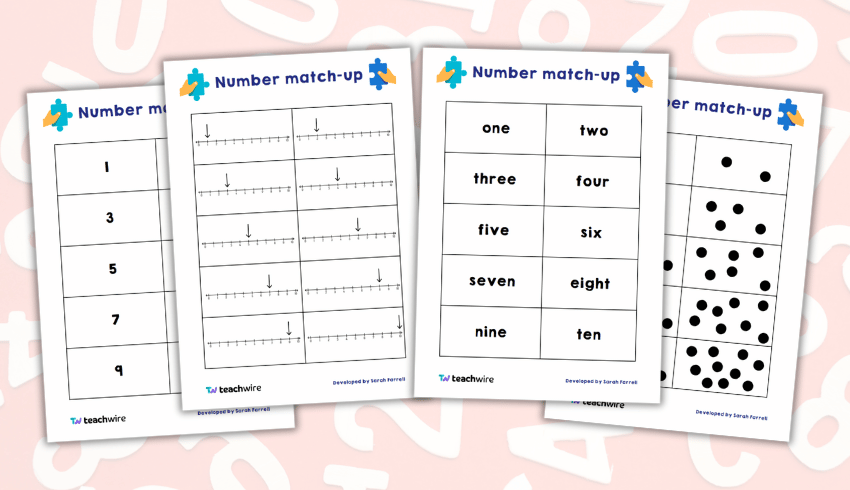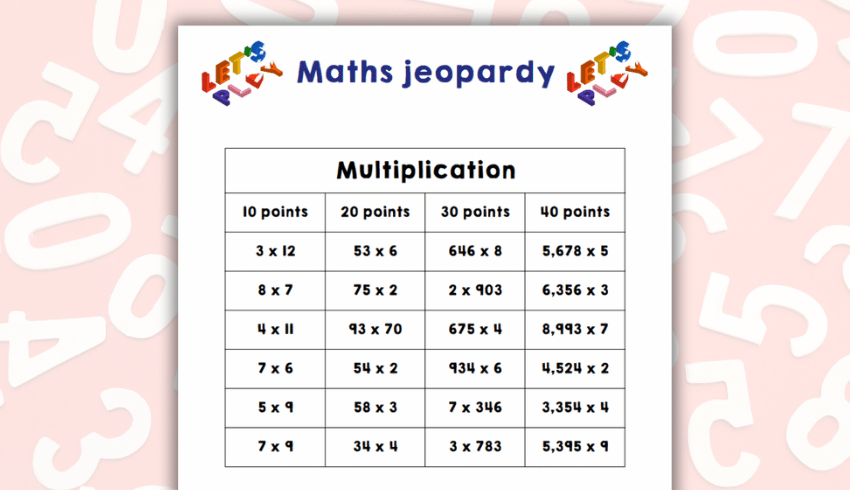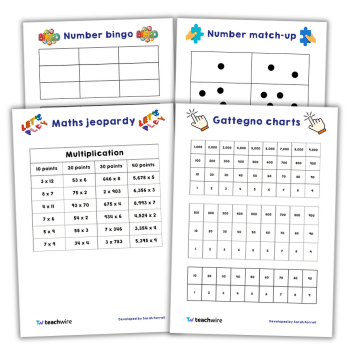Use these activity ideas and downloadable resources on Number Day to help raise awareness for the NSPCC, and engage in some maths fun at the same time…
There are many different ways to celebrate Number Day. You may decide to dedicate the entire day to maths-related activities, or you might just add a Number Day twist to your existing maths lesson.
Whatever you choose to do, here are some ideas (and downloadable templates) to get you started…
What is Number Day?
Number Day, organised by the NSPCC and celebrated annually in February, encourages schools to engage children in fun, maths-related activities while also raising awareness and support for the NSPCC’s vital work.
As a teacher, you can inspire your students to explore numbers through a range of practical, engaging ideas and activities.
When is Number Day?
In 2025, Number Day falls on Friday 7th February. Register at the NSPCC website.
Why celebrate Number Day?
- It promotes positive attitudes towards maths. Some children may have the perception that maths is solely about solving calculations. Celebrating Number Day shows pupils that maths is a fun and enjoyable subject.
- It develops collaboration and teamwork. Often, maths lessons mainly involve children working independently. Number Day provides the opportunity to engage in group activities with turn-taking games or paired challenges, which promotes social skills and communication.
- It builds confidence in maths. Allowing children to practise their maths skills through games and challenges gives them an opportunity to be successful and be supported by friends.
Number Day ideas
Number match-up

Resources: Sets of cards with different representations of numbers on them (included in this download). For KS2, the children could create these themselves.
How it works:
- Lay out the cards face down.
- Children take it in turns to flip over two cards.
- When the find a match (eg 4 and four), they keep the pair and take another turn. If they do not turn over a match, they return the cards face down.
- Continue until all matches are found. The child with the most pairs wins.
KS1: Practise subitising and number recognition by using digits and written words or images representing the numbers.
KS2: Include times table multiplication facts, Roman numerals or other representations.
Number bingo
Resources: Bingo cards with numbers (or mini whiteboards for children to write their own numbers); pens or counters.
How it works:
- Either provide children with bingo cards (included in this download) or ask them draw a 3 x 3 grid and input their own numbers between 1 and 100.
- Call out numbers. When they hear a number that they have, children cross out their number or put a counter over it.
- The first child to complete a row or column (or the entire grid) shouts “Bingo!” and wins.
KS1: Practise number recognition by calling out the number, or challenge children by calling out a calculation, eg “4 + 8”. You may also want to limit number choice to within 20 or 50.
KS2: Challenge children by displaying the number in Roman numerals or by giving them a harder calculation to find the number, eg “3 x 2 x 4”.
Maths jeopardy

Resources: Questions separated into categories (addition, subtraction, etc.) and arranged in point values (included in this download).
How it works:
- Divide the class into teams.
- The first team chooses a category and a points value. Ask a question that fits into the chosen category (eg if it’s addition, you could ask “What’s 5 + 8?”. If they answer the question correctly, they win the number of points they chose for the points value.
- At the end, total up the scores. The team with the most points wins.
- To make the game as effective as possible, choose questions that target areas that you know your class need to practise or areas that they have recently covered in lessons.
Maths scavenger hunt
Resources: A list of challenges or items to find, described in mathematical terms.
How it works:
- In pairs or small groups, children work together to complete the scavenger hunt.
- Gather children afterwards to share and compare their findings and to discuss the maths involved.
KS1: Depending on the confidence level of pupils, tasks could revolve around counting (“Collect 3 leaves”), measuring (“Find a pencil that is longer than 12cm”) or shape (“Find a cylinder”).
KS2: Tasks can become more complex, such as finding an object longer than 11.2 cm but shorter than 12.5 cm, or involve investigation:
- Measure the length of one of the benches
- Count how many chairs the classroom has and multiply the answer by 2
- Check out this range of maths game ideas for KS2
- Download resources for a fun Guess Who style KS2 maths game
- Browse a list of exciting maths games for KS1
Even more Number Day ideas
Explode a number
Resources: Mathematical manipulatives and large pieces of paper.
How it works:
- In pairs or small groups, give children a number.
- Using manipulatives or through writing and drawing, ask children to create as many different representations of a number as they can. They may write the number in words, use place value counters or a Gattegno chart (included in this download), or write the number in expanded form. KS2 children may find the factors of the number, write it in Roman numerals or write calculations that give the target number as an answer.
- Whoever can create the most representations of a number wins.
Guess the number
Resources: 100-square grids (included in this download)
How it works:
- The teacher or a child chooses a number between 1 and 100.
- Children then ask yes or no questions to work out the number, eg “Is it an even number?”
- Cross out the numbers that can be eliminated as you go, until only one number is left.
KS2: Challenge older children by giving them words that they must include in their questions, eg prime, factor, multiple, divisible, square, cube.
Number riddles (KS2)
Resources: 100-square grids (included in this download)
How it works:
- Children choose a number and think of clues to give to other children so they can work out the number.
- Each clue should narrow down the possibilities, but it shouldn’t reveal the answer too soon. Eg “My ones digit is even, but my tens digit is odd. I am divisible by 3. I am 5 more than a square number. My digits have a sum of 9.”
- Cross out the numbers that can be eliminated as you go until only one number is left.
Maths relay
Resources: A range of maths word problems or puzzles.
How it works:
- Give children the first problem or puzzle to solve. This works best in pairs, but could be individually or in small groups.
- When they think they have the answer, one child runs up to the teacher and checks it with them. If they get it right, they take the next puzzle. If they don’t, they return to their table and try again.
- For this to be successful, the puzzles and problems should be solvable with a little challenge so that children are able to be successful.
- The first team to get through all the puzzles correctly, wins.
Dice games (KS2)
Resources: Dice (10-sided dice would work best for this, but it would still work with 6-sided dice).
How it works:
- On the whiteboard, draw out a template (eg 6 boxes next to each other to create a 6-digit number). Children copy this down onto a whiteboard or on paper.
- Set the challenge. This may be trying to make the smallest number, the greatest number, the number closest to 500,000 – the possibilities are endless!
- Children should then take it in turns to roll the dice and select which of their boxes to put the digit in. They will have to choose carefully to try to achieve the target number.
- This could be extended by formatting the challenge as a calculation, such as __ __ __ __ __ + __ __ __ __ and asking the children to come up with an addition question with an answer as close to 60,000 as possible.
Sarah Farrell is a KS2 teacher in Bristol who makes and shares resources online. Follow Sarah on Twitter at @SarahFarrellKS2 and see more of her work at mrsfclassroom.wordpress.com











